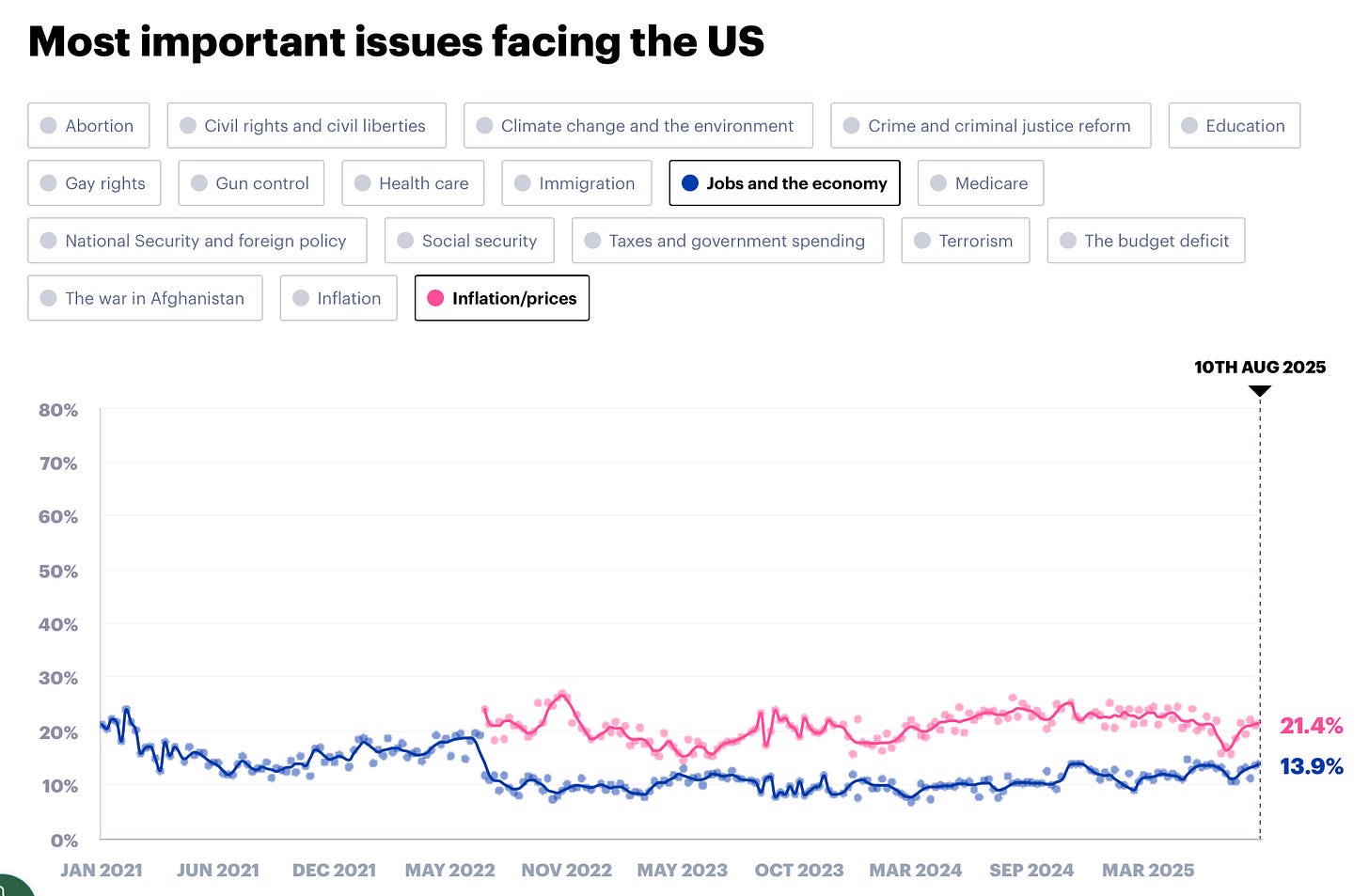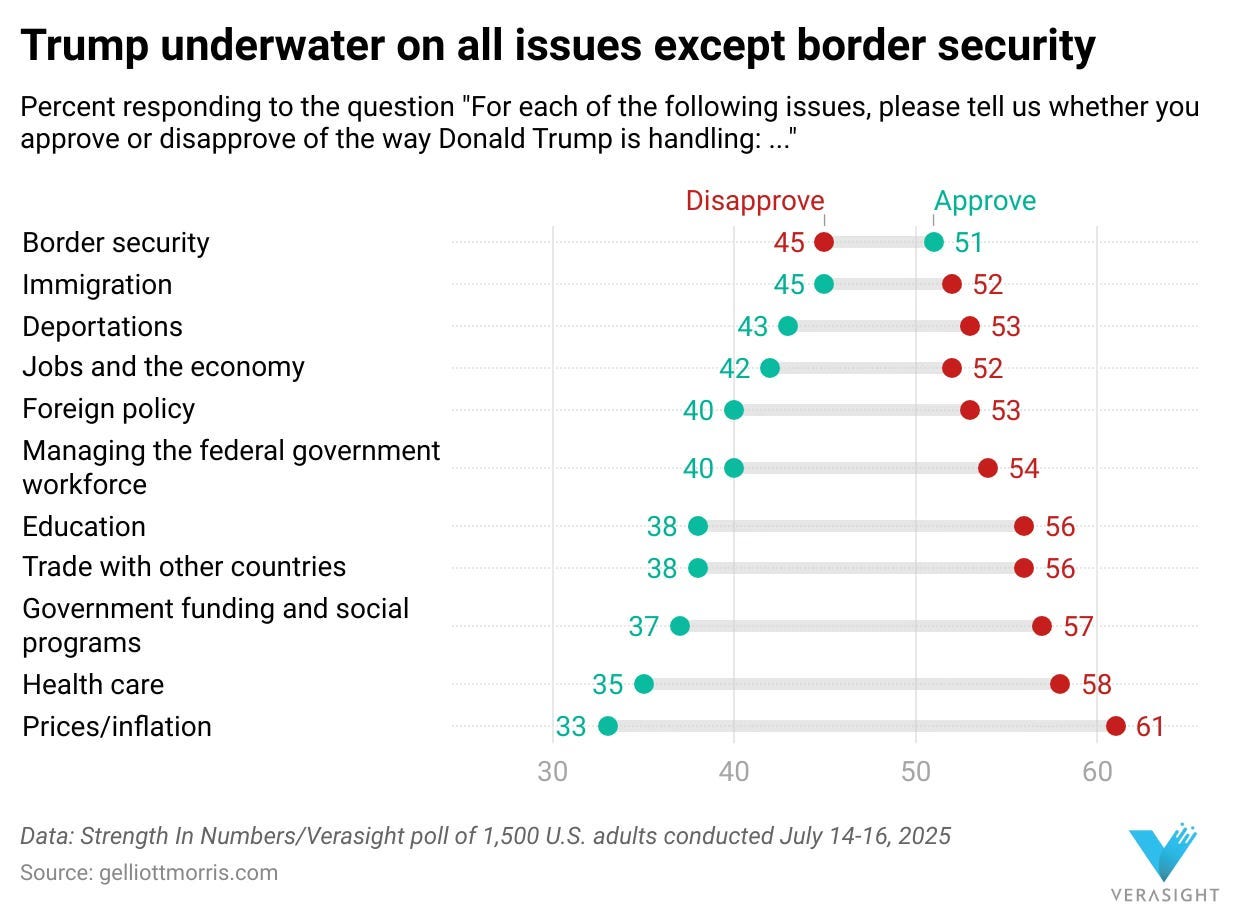Trump is as unpopular on inflation as Biden was in 2022
The president’s approval rating on prices and the economy is approaching Joe Biden’s low point during peak inflation
New BLS data published on Thursday show a troubling increase in the Producer Price Index — a measure of the price of goods listed by businesses, before consumers get the bill — and a resurgence in inflation. For context, here’s a graphic of annual change in the PPI from the St Louis Fed.
The new PPI number was reported as “scorching hot,” spooking markets (investors are less confident the Fed will cut interest rates now, which Wall Street wants) and cited as evidence that Trump’s tariffs are starting to impact prices.
Once costs rise for businesses, it’s only a matter of time until prices increase for consumers.
But prices are Trump’s biggest political vulnerability. Inflation was the top reason for defectors from Biden to Trump (or not voting) between 2020 and 2024, and getting prices down was his biggest promise of the 2024 campaign. If Trump fails to keep inflation under control (or, indeed, make it worse), he could lose even more ground with the public, hurting his political capital in Washington.
In this week’s Chart(s) of the Week, I wanted to share a few graphs that I think show how Trump is very exposed on prices. For a couple of reasons, I think he’s at real risk of inflation sinking his presidency — just like it did Joe Biden’s.
1. Prices are still important to people
Despite annual inflation coming down in 2024, prices are a continued source of stress for voters. This makes inflation a constant threat to incumbent parties, regardless of who’s in charge. And according to the data, Trump isn’t handling that threat well at all.
In polling by YouGov, a combined 36% of U.S. adults say that jobs and inflation are their number one priority. This is a notable increase from 28% during the first month of Trump’s second term, and about equal to the high point of this number during Joe Biden’s presidency:
Yes, you read that right. People are just as concerned about inflation today as they were during the height of inflation in Biden’s term, in 2022-2023. People have not covered inflation as a significant issue under Trump, considering it a large liability (since he won on a campaign promise to turn the economy around in 2019), but I think it’s time for people to update their priors on this.
Prices are just as big a political liability for Trump as they were for Biden.
2. Trump is underwater on prices
And now, let’s look at how Americans rate Trump’s handling of prices. The data below comes from our July Strength In Numbers/Verasight poll of 1,500 US adults.
According to our data, 61% of Americans disapprove of how the president is handling inflation, and 52% disapprove of his policies on jobs and the economy. As the recent PPI data make clear, the biggest variable impacting inflation right now is Trump’s taxes on imports, which a majority of voters (56%) also disapprove of.
Currently, Trump’s net rating on handling inflation (the difference between the share of adults who approve versus disapprove of how he’s doing on the issue) is -28 percentage points in our polling data. This is equal to Joe Biden’s average net approval on inflation from 2022 through 2023, visualized below.
And you don’t have to take my and YouGov’s word for this. The average of polls also has Trump deep, deep underwater on all three of tariffs, jobs/the economy, and prices:
Yikes!
Taking stock so far, we have established three things:
Prices are increasing
Inflation is just as important to voters as it was in 2022-2023
Trump has an approval rating on inflation as low as Joe Biden’s ratings in 2022-2023, and is almost meeting the former president’s all-time low in 2024
This is not the public opinion data you’d expect based on what Trump promised during the 2024 campaign.
Support data-driven journalism!
Become a paying member of Strength In Numbers today and get exclusive posts, early access to data, and more.
Your support helps fund polling trackers, original polls, deep analysis, and data-driven journalism that cuts through the noise of today’s media landscape. Support our site and tell the world that when it comes to the news and democracy, there is strength in numbers.
3. Trump is underwater on tariffs in all key states
Finally, a short recap of my article last Friday:
If you take our Strength In Numbers/Verasight polling data from May through July and feed it into a model to predict the opinions of every adult in America (based on demographics available in the Census), you get the following map. Trump is underwater on trade/tariffs in 40 out of 50 states:
Some key states for 2026:
Iowa: Trump -12
Texas: Trump -13
North Carolina: Trump -14
Georgia: Trump -16
Michigan: Trump -18
Maine: Trump -22
Needless to say, the GOP is going to have a bad time if inflation goes to 5% and Trump stays underwater on tariffs in every single swing state.
Based on what he promised in 2024 and the current reality of tariff-induced inflation, I think prices are Trump’s biggest political liability. The president has pushed his inflationary policies out in the open, even conceding they may raise prices — remember the administration’s line in April was that there was going to be some “short-term pain” from Trump’s agenda, but that on-shoring some manufacturing would be worth it.
America has lost 37,000 manufacturing jobs since April.






It's a long way from November 2026. I pray that whether it's cost of living or Epstein or healthcare or whatever, that Democrats organise, make their case and take back congress. With all the redistricting and other initiatives it may be that a bigger swing to the Democrats is needed. Time to present the thoughtful, considered policy agenda to improve peoples' lives and hope that helps drive turnout. Or is not being Trump sufficient? A blue tsunami next year would be wonderful.
For a good look at how prices and high inflation are affecting the lives of people, I suggest reading the post, "Will Work for Food," in Jess Piper's Substack, "The View from Rural Missouri," Then read the comments. The effect on people is real, and they are noticing.